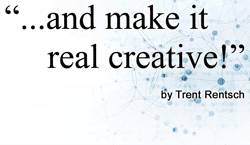By Trent Rentsch
 I can’t promise immortality, but you may find that your story is more memorable, and in the end isn’t that what we hope for, that our Creative will grab our Listener’s by the ears and inspire action? A heady goal in a world over-run by stories. So what can make your story stand out? Often, it all depends on where it begins, or more precisely, when.
I can’t promise immortality, but you may find that your story is more memorable, and in the end isn’t that what we hope for, that our Creative will grab our Listener’s by the ears and inspire action? A heady goal in a world over-run by stories. So what can make your story stand out? Often, it all depends on where it begins, or more precisely, when.
We learn as children how stories work. There is a beginning, middle, and end. “Once upon a time there were people, then seemingly insurmountable adventures happened, but they all lived happily ever after.” It’s a comfortable, linear way to weave a story. People recognize it and understand it. But sometimes, disrupting this “normal” pattern can make a story more compelling. What if you start with the end, or the middle? What if the beginning is the end? How will it change your listener’s perspective… and how will it push you Creatively?
Hemingway was one of those legendary Creatives whose own life story was as big as tales he wrote. One of his legends has to do with a wager he made with a table of fellow Writers. As the story goes, he bet each man 10 dollars that he could write a story in six words. He then scribbled on a napkin, “For sale: baby shoes, never worn.” Whether the story is true or just another tale that enhances his legend as a Creative genius is unclear, but what is clear is that the story begins at the end, and haunts the reader with the beginning and middle left unspoken. It’s a powerful example for our purposes not only because it makes compelling use of non-linear story-telling, but also because it does so in six short words, proving how effective it can be, even in our time-limited Creative medium.
Non-linear story-telling is nothing new to advertising. Bank of America flipped the beginning and end (more or less) in their “Before” series of ads. If you haven’t seen them, the ads focus on the positive financial outcomes (endings) that people have, all because they were approved for the Bank of America card (where it all began). Flipping the end and the beginning is a twist that arguably makes an otherwise dry credit card ad compelling to the end. An example closer to home would be a promo that starts out with the happy screaming of a station contest winner, followed by what and how they won, and ending with how the person listening to the promo could win themselves. It disrupts the usual pattern of contest promos and grabs the listener... why is that person so damned happy? I want to be that happy... HOW?
So far we’ve talked about beginning with the end. What about moving the middle to the beginning…
(creepy music)
V1: I am NOT going back in there!
V2: Please, help me!!
V1: Are you crazy?! Can you hear that screaming?
V2: Here, this will protect you!
V1: A Dairy Giant Ice Cream cake?
V2: You’re the one who said till death do us part…
V1: You’re the one who invited 18 12 year-old girls to our daughter’s sleepover…
Annc: Chill out, it’s just a Birthday… order a Dairy Giant Ice Cream Cake.
There are a couple of things I like about beginning the story in the middle. First, it bypasses all the set-up nonsense so many scripts have and gets right into the action. Second, it gives the listener a false sense of what’s really going on, making the ending a bigger twist. Horror movies have done this for years, and much better than my feeble ice cream cake script. Think the nice guy who has been among the protagonists throughout a movie, who turns out to be the killer... not only picking off his current friends one by one, but also friends and family long before the movie began. HIS story started as a small boy, force-feeding his sister ice cream cake until she exploded, but the movie story begins long after that...
When it comes down to it, that’s what makes non-linear story-telling so compelling, and in many ways more real. We all have our own beginnings, middles and endings, and our paths cross at different points in each other’s stories. We don’t really know the whole story of anyone but ourselves, and it’s those discoveries that can make life interesting and surprising. The next time you write a script, consider what point in the story you’re telling REALLY makes the most powerful beginning, and attack it from that point on. It doesn’t always have to be once upon a time.
■
Trent Creates words, voices, audio and music. His professional home is Krash Creative. Write him:

